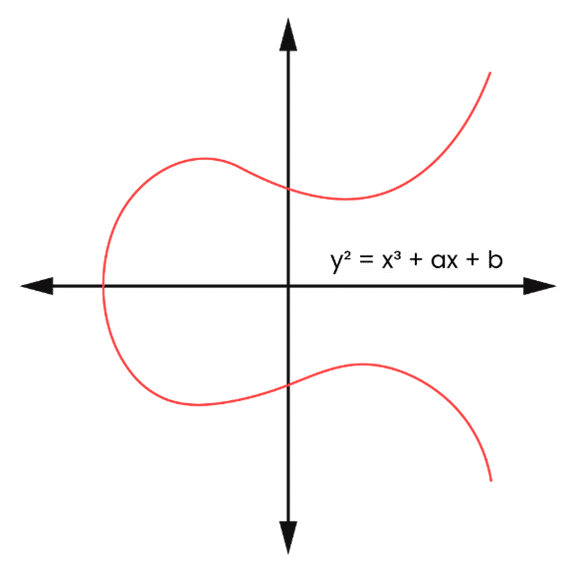Imagine you’re sending a private message to a friend, shopping online, or transferring cryptocurrency. In each case, you trust that your secrets—your words, your credit card number, your digital coins—stay safe from attackers’ eyes through encryption. But how does that happen?
Many applications require secure communication, data integrity, authentication, or non-repudiation. These often rely on the robust security provided by a concept called public-key cryptography, also known as asymmetric cryptography.
Public-key cryptography plays an important role in many secure systems, enabling safe data exchange across the internet. Now, there are several important types of algorithms used in public-key cryptography, such as RSA, ECC, DSA, DH, and ElGamal, each relying on different mathematical principles to ensure security – for example, RSA uses factorization, ECC uses elliptic curves, and DH leverages discrete logarithms. In this blog, we will be learning and understanding one such algorithm called ECC or Elliptic Curve Cryptography.
What Is Elliptic Curve Cryptography or ECC?
ECC is a type of public-key cryptography, a system where you have two keys: one you share with the world (public key) and one you keep as a secret (private key). However, what makes ECC special is its use of elliptic curves, which, in cryptographic contexts, are defined over finite fields by an equation like y² = x³ + ax + b. Mathematicians have been studying these curves for centuries. However, in 1985, two brilliant thinkers—Neal Koblitz and Victor S. Miller—discovered that they could use these curves to revolutionize cryptography, enabling stronger security with smaller key sizes compared to other methods.

The main advantage of Elliptic Curve Cryptography (ECC) lies in the mathematical problem it relies on for security. To better understand this concept, let’s look at the example below:
Imagine a graph with a special, curvy line on it – that’s our elliptic curve. Now, there are two people, Alice and Bob, who have agreed on a common starting point, G, on the curve. They also agreed upon a set of rules (specifically scalar multiplication), or a recipe for easier understanding, to be followed when moving on the curve.
Alice picks a secret number (let’s say ‘a’), and Bob picks their own secret number (‘b’). These are their private keys – they keep these numbers completely to themselves, like a secret code only they know.
Alice takes the agreed-upon starting point ‘G’ and follows the “recipe” a times, performing scalar multiplication to compute aG. Imagine taking ‘a’ steps on the curve according to the rules. The point she ends up at is her public key, denoted as A (where A = aG). She can share this point ‘A’ with anyone. Similarly, Bob takes the same starting point ‘G’ and follows the “recipe” ‘b’ times, computing bG, ending up at his public key, denoted as B (where B = bG), which he can also share.
Now, Alice takes Bob’s public key ‘B’ and follows the same “recipe” she used with her secret number ‘a’ times, computing aB (which is a(bG) = abG). This leads her to a specific point on the curve. At the same time, Bob takes Alice’s public key ‘A’ and follows the “recipe” he used with his secret number ‘b’ times, computing bA (which is b(aG) = abG). This also leads him to the same point on the curve, the shared secret abG.
Due to the special mathematical properties of elliptic curves and the “recipe,” the point Alice arrives at will be exactly the same as the point Bob arrives at! For secure communication between two parties over an unsecure network, a secret key needs to be generated so that it can then be used for efficient and secure data transmission or for authentication purposes. This shared point is their secret key.
Now, even if someone is eavesdropping and sees the curve, the starting point ‘G’, Alice’s public key ‘A’, and Bob’s public key ‘B’, it’s incredibly difficult for them to figure out Alice’s secret number ‘a’ or Bob’s secret number ‘b’. This is because determining the number of steps taken to reach ‘A’ or ‘B’ from ‘G’ is a challenging mathematical problem known as the Elliptic Curve Discrete Logarithm Problem (ECDLP). Reversing this “secret walk” on the elliptic curve – finding out how many steps (‘a’ or ‘b’) were taken to get from ‘G’ to ‘A’ or ‘B’ – is computationally infeasible with current technology.
Essentially, the challenge of figuring out how many steps were taken to get from the starting point to the final point using ECDLP is the seemingly simple but computationally incredibly difficult task of determining the secret number ‘a’. Even with powerful computers, trying to reverse this process on a properly chosen elliptic curve with a sufficiently large key size is so time-consuming that it’s practically impossible within any reasonable timeframe.
This makes ECC a powerful and efficient tool for securing our digital world, from websites and emails to cryptocurrencies and mobile devices.
ECC vs RSA
When it comes to public-key cryptography, two algorithms have long stood out as heavyweights: RSA (Rivest–Shamir–Adleman) and ECC (Elliptic Curve Cryptography). Both achieve the fundamental goal of secure communication through public and private key pairs, but they go about it in fundamentally different ways, leading to some crucial distinctions.
| Feature | RSA | ECC |
|---|---|---|
| Security Based On | Factoring large composite numbers | Elliptic Curve Discrete Logarithm Problem |
| Key Size (in bits) | Larger for equivalent security | Smaller for equivalent security |
| Performance | Can be slower for comparable security | Generally faster for comparable security |
| Resource Usage | Higher (storage, bandwidth, processing) | Lower (storage, bandwidth, processing) |
| Adoption | Historically widespread, still common | Rapidly growing, especially in modern apps |
| Best Suited For | Wide range of applications, legacy systems | Mobile, IoT, modern secure protocols |
Comparing the Security Strengths
When it comes to locking up your digital secrets, cryptography offers symmetric block ciphers and asymmetric-key algorithms. Symmetric block ciphers, like the Advanced Encryption Standard (AES), use a single key to both encrypt and decrypt data, while Asymmetric-key algorithms, like ECC and RSA, use a pair of keys: a public key to encrypt (or verify signatures) and a private key to decrypt (or sign).
Now, security strength is about how hard it is for an attacker to crack the system. For symmetric ciphers, strength is tied to the key size since the only way to break them (without flaws) is by brute-forcing every possible key. Asymmetric algorithms, though, face different attacks (like solving discrete logarithms for ECC or factoring for RSA), so their key sizes don’t directly match symmetric ones. Notably, ECC’s advantage is more effective in constrained environments, such as mobile devices and IoT systems, where its smaller key sizes provide strong security with less computational overhead. Then, how do we measure their strengths together?
According to the National Institute of Standards and Technology (NIST), symmetric and asymmetric algorithms can be compared by their equivalent security levels or in bits of security (NIST SP 800-57 Part 1, Revision 5), which provides the following mappings to estimate the computational effort required for an attack. This allows security professionals to select an algorithm based on performance versus security needs.
| Symmetric Key Size | ECC Key Size | RSA Key Size | Security Strength (Bits) |
|---|---|---|---|
| 128 (AES-128) | 256–283 | 3072 | 128 |
| 192 (AES-192) | 384–511 | 7680 | 192 |
| 256 (AES-256) | 512+ | 15360 | 256 |
As you can see, ECC achieves the same security as AES or RSA with much smaller keys. A 256-bit ECC key matches AES-128’s strength, while RSA needs 3072 bits to keep up. Now, let’s learn about the whys and why-nots of using ECC in real-life applications in detail.
Pros and Cons of Using Elliptic Curve Cryptography
Like any cryptographic algorithm, ECC comes with its own set of strengths and weaknesses. Understanding the pros and cons is important for learning about its role in modern security and for making informed decisions about its use.
Pros of ECC
- Smaller Key Size: ECC can achieve the same level of security as older public-key systems like RSA with significantly shorter key lengths, including reduced storage, lower bandwidth consumption, and faster computation.
- Mathematical Complexity: The underlying mathematics of elliptic curves provides a strong foundation for security, with no known sub-exponential-time attack against the Elliptic Curve Discrete Logarithm Problem (ECDLP) on a well-chosen curve, making it difficult for attackers to find shortcuts to break the encryption.
- Advanced Security Features: ECC enables advanced security features like Perfect Forward Secrecy (PFS) when used in protocols like ECDHE, enhancing the resilience of secure communication.
Cons of ECC
- Relatively New: Compared to the decades of analysis that RSA has undergone, ECC is a newer technology. While it has been extensively studied and is considered secure by experts, it hasn’t faced the same length of public scrutiny.
- Curve Selection is Critical: The security of ECC heavily relies on the choice of the elliptic curve parameters. Using weak or poorly chosen curves can lead to vulnerabilities.
- Less Widespread Legacy Support: While adoption is growing rapidly, some older systems or protocols might have limited or no support for ECC compared to the more universally supported RSA.
These pros and cons should be considered in the context of specific use cases, system requirements, and security goals to determine whether ECC is the right choice for a given application.
Applications of Elliptic Curve Cryptography
The robust security of ECC is used in many applications that you likely use every day. Here are some key areas where ECC plays a crucial role:
- Digital Signatures and Code Signing: ECC provides a strong and efficient way to create digital signatures for documents, software, and firmware updates. These signatures ensure the authenticity of the sender and the integrity of the data, guaranteeing that it hasn’t been tampered with since it was signed.
- Securing the Web (HTTPS): When you browse a website with “https://” and see that padlock icon, ECC is often at work during the TLS/SSL handshake. Its smaller key sizes enable faster and more efficient establishment of secure connections between your browser and the web server, which is especially beneficial for mobile devices with limited processing power and bandwidth.
-
Cryptocurrencies and Blockchain: ECC, particularly the ECDSA (Elliptic Curve Digital Signature Algorithm) variant, is a fundamental building block for most cryptocurrencies like Bitcoin and Ethereum. It’s used to:
- Secure wallets: Ensuring that only the owner of the private key can authorize transactions from their digital wallet.
- Verify transactions: Allowing the network to cryptographically verify the authenticity and integrity of every transaction recorded on the blockchain.
- Internet of Things (IoT) Devices: The resource-constrained nature of many IoT devices makes ECC an ideal choice for securing their communication and data. Its small key sizes and efficient operations are well-suited for devices with less processing power, memory, and battery life, ensuring secure data transmission from smart sensors to connected appliances.
- Secure Shell (SSH): For secure remote access to servers and systems, SSH often utilizes ECC for key exchange and authentication, providing a more efficient and equally secure alternative to traditional algorithms.
- Secure Key Exchange: ECC is also widely used in the Elliptic Curve Diffie-Hellman (ECDH) protocol for secure key exchange, enabling two parties to establish a shared secret key over an insecure channel, which is critical for encrypting subsequent communications.
Encryption Consulting’s CodeSign Secure
CodeSign Secure helps software developers and organizations build trust with users. It ensures the authenticity and integrity of software releases by leveraging ECC for enhanced security and efficiency.
CodeSign Secure uses ECC, specifically the Elliptic Curve Digital Signature Algorithm (ECDSA), with key types like P-256 and P-384, to create digital signatures. These signatures verify that the software hasn’t been tampered with. This approach provides high-speed signing and verification with top-tier security. It protects against threats like malware injection or unauthorized code modifications. However, CodeSign Secure is more than just ECC—it’s a comprehensive solution to elevate your organization’s security standards.
CodeSign Secure leverages ECC, specifically through the Elliptic Curve Digital Signature Algorithm (ECDSA), to create digital signatures that verify software hasn’t been tampered with. This will provide you with high-speed signing and verification with top-tier security, protecting against threats like malware injection or unauthorized code modifications. But CodeSign Secure isn’t just about ECC – it’s a full-fledged solution to improve your organization’s security standards.
It supports various hardware security modules (HSMs) that are compatible with standards like PKCS#11 and FIPS 140-3, which store ECC keys in tamper-proof hardware. It also allows the automation of signing workflows to reduce the chances of human error by integrating seamlessly into CI/CD pipelines like Jenkins, Azure DevOps, GitHub Actions, and many more.
It ensures digital signatures meet strict industry requirements, reducing non-compliance risks. Detailed audit trails and logging reports track every operation. With its seamless scalability, CodeSign Secure is an ideal solution for businesses to strengthen and improve their software’s security.
Conclusion
Elliptic Curve Cryptography stands as a powerful and increasingly vital algorithm due to its elegant mathematical foundation, which allows it to deliver strong protection with remarkable efficiency and significantly smaller key sizes compared to older algorithms. Its widespread adoption is reflected in numerous security standards, including TLS 1.3, FIDO2, and S/MIME.
From securing our web browsing and mobile communications to strengthening the functionality of cryptocurrencies and ensuring the integrity of software through code signing, ECC’s influence is pervasive. Furthermore, while ECC provides robust security against current computational threats, researchers are actively investigating its potential evolution and the development of ECC-based strategies that could offer protection even in a post-quantum computing era.




